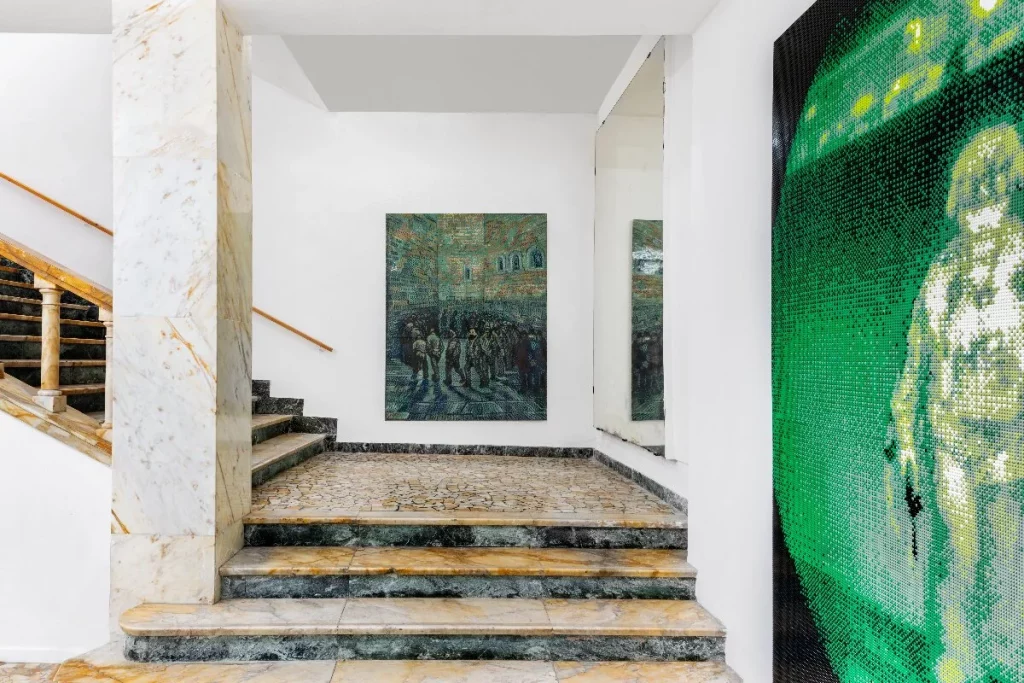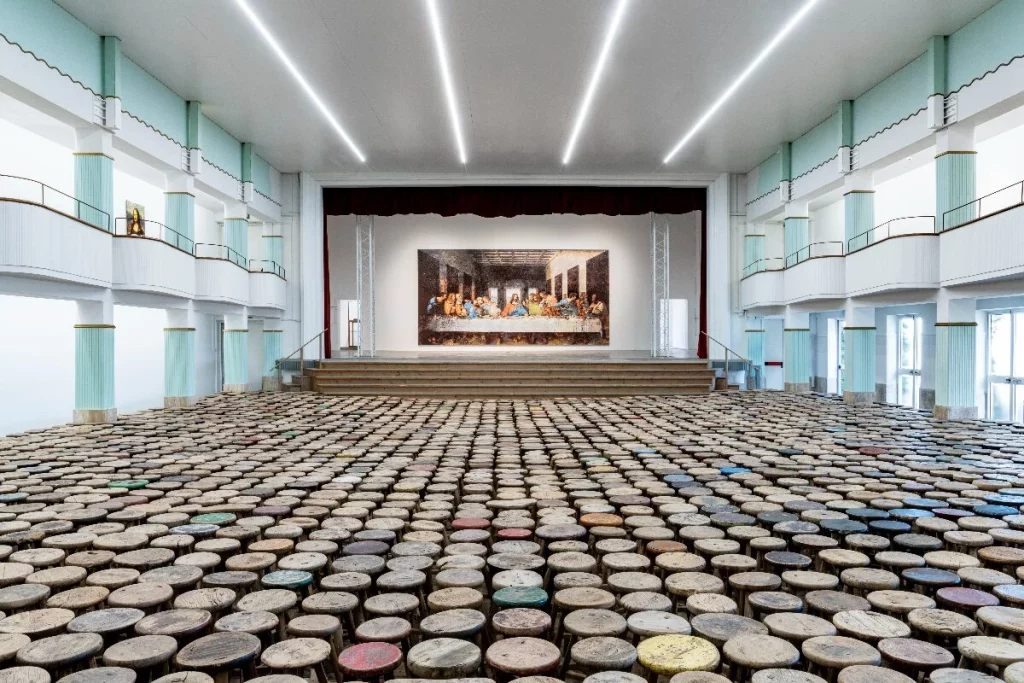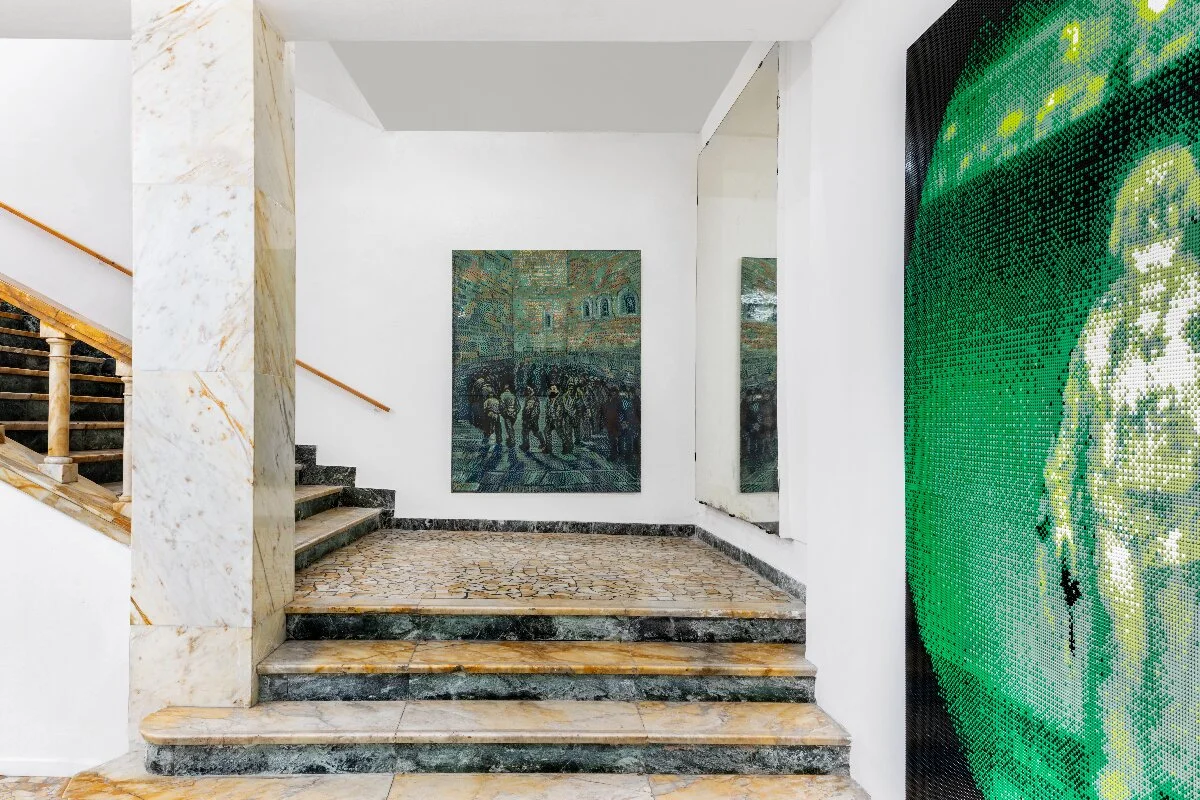Ai Weiwei returns to Italy with the exhibition Neither Nor at Galleria Continua in San Gimignano, Tuscany. Between lego, antique stools and criticism to art critics, the artist confirms to be a maverick thinker
On human fragility: the repression of free expression. Today as yesterday, in China as everywhere
In Italy, during the last few weeks, the media and public opinion have paid particular attention to what happened in Pisa (Tuscany) on the 23rd of February. Students, some of them minors, were truncheoned by the police while peacefully demonstrating in favor of Palestine. In relation to China, you have criticized and experienced similar coercive mechanisms implemented by the government. Expanding the gaze to today’s international situation, do you think the repression of acts of free expression is a timeless dynamic that highlights the sociocultural regression we are experiencing?
AI WEIWEI «In today’s media landscape, we witness conflicts unfolding across the world in various forms, encompassing demonstrations, protests, clashes with law enforcement, as well as more complex international military confrontations. Never before in human history has violence and death been so pervasive in both media coverage and public discourse.
Reflecting on my own experiences in China, I’ve encountered similar situations. Yet, I don’t view these encounters as mere clashes between protesters and law enforcement. Rather, I see them as manifestations of individuals exercising their rights in opposition to established power structures, including governmental authorities, law enforcement agencies, and the maintenance of public order.
This underlying contradiction has become increasingly pronounced in today’s world and cannot be easily resolved. Violence only begets further animosity, leading to a cycle of hatred that perpetuates new forms of violence. It is a societal cost that we inevitably incur amidst the tumultuous landscape of rapid and imbalanced development».

Through Dadaism to Ai Weiwei’s mindset – criticism to art critics
FEDERICO JONATHAN CUSIN In a world at war, the Dada movement is extremely relevant. Tristan Tzara writes that «art is a private affair. The artist produces it for himself […] What we need is works that are strong straight and forever beyond understanding». Who do you create your art for and how crucial is it for you that it is understood?
AI WEIWEI «First and foremost, my artworks are created for myself. When I conceive an idea that resonates with me, whether it’s intellectually stimulating or encourages deeper introspection and action, I pursue it without hesitation. I firmly believe that if I find the idea compelling, it will naturally pique the interest of others, as I am fundamentally no different from anyone else».
FEDERICO JONATHAN CUSIN Tzara also pointed out that «the artist is happy when he feels insulted: proof of his inconsistency». A few art critics have described your works and stances as “sly”. How do you relate to criticism, does the insult pleased you in a certain way?
AI WEIWEI «When art faces critique, it has the potential to evoke a heightened sense of contradiction and provoke deeper reflection on aesthetic and ethical matters. Yet, in contemporary times, genuine art criticism is waning as entertainment replaces rigorous philosophical inquiry. While I welcome criticism of my work, I find it rare to encounter truly insightful critiques. Often, criticism merely exposes the limited perspectives of those who engage in it».
Being shameless for over twenty years: does Ai Weiwei’s intellectual irony provoke more reaction or reflection?
FEDERICO JONATHAN CUSIN In your post of 12 July 2006 – Because I am a hypocrite – you talk about shamelessness in relation to your media celebrity. The immediacy with which you communicated online sometimes seems to be reflected in how you express yourself artistically. Eighteen years later, does your brazenness still have an influence in provoking more reaction than reflection in those who come across your work?
AI WEIWEI «This question is quite intriguing because the article in question is actually a piece of satire. If I recall correctly, it also critiqued the prevalent consumer-driven popular culture and entertainment-centric societal consciousness. Such themes are recurrent in my artworks. Criticism is embedded in all my creations. While it may not always elicit a widespread response, it does provoke thought in some individuals».
To destroy with kindness means to educate in the deconstruction of the mundane structure
FEDERICO JONATHAN CUSIN In 2020, you answered twenty questions from your son, Ai Lao. At one point, he asks you why it is easier to destroy than to create. If for you resistance to destruction is an intergenerational value to be passed on to the younger generation, how would you educate them in choosing what to destroy to make room for the new?
AI WEIWEI «The primary issue with contemporary education lies in its persistent endeavor to occupy mental space and instill a mundane structure aimed at facilitating the acquisition of a predetermined sense of security, thus perpetuating an accepted value system. Genuine education should instead guide young individuals toward identifying and rectifying the shortcomings of the educational system and encourage deconstruction. Without clearing this space, all acquired knowledge remains futile».
Neither Nor – Ai Weiwei’s new exhibition at Galleria Continua in San Gimignano
FEDERICO JONATHAN CUSIN The concept of choice – or exclusion from taking one – inhabits your new exhibition Neither Nor at Galleria Continua. Many of your exhibited artworks are composed of Lego. Does the chromatic and geometric combination and decomposition of these small pieces reflect your interest and work in architectural design as well as in some masterpieces of art history?
AI WEIWEI «My interpretation of LEGO is that it represents a novel form of language, relying on digits and pixels to function as a linguistic medium. I find this concept highly intriguing. Despite their seemingly two-dimensional nature, my LEGO artworks operate as a structural method. In terms of assessing art history and politics, it serves as a tool for deconstruction. This is an aspect that has recently captured my keen interest».
The sense of history through art: a ready-made of over two thousand stools
FEDERICO JONATHAN CUSIN The auditorium of the former cinema-theater in San Gimignano hosts your installation Stools (2013) composed of over 2586 wooden stools from the Ming (1368-1644), Qing (1644-1911) dynasties and from the Republican era. How did the idea of combining these everyday objects that transcend centuries come about?
AI WEIWEI «When I engage in creating large-scale artworks, I come to realize that our conventional notions of lifestyle habits and practices, as well as our interpretations of history, undergo a profound transformation in terms of perspective and function. This transformation gives rise to an unimaginable self-contradiction: how does its function cease to exist? This is the fundamental thought behind all of the ready-mades».

On photography – its limits close to authenticity
FEDERICO JONATHAN CUSIN In the past, you have described photography as a deceptive and dangerous medium, which you seem to still often use today. Is it always for you a vehicle of artistic creation or more a way of recording and sharing the present also through social platforms such as Instagram?
AI WEIWEI «I believe that photography cannot be classified as art, but rather as a medium for documentation. It does not embody “authenticity” but rather operates as a medium that exists alongside authenticity. Through photography or exhibitions, our actions aim to undertake activities that run parallel to our existence».
When being excluded from exhibitions is a result of non-self-censorship
FEDERICO JONATHAN CUSIN According to the Press Freedom Index, Italy ranks 41st in the world. Until a few decades ago, censorship was a very present grip. Considering the censorship operated by the Chinese government today – China ranks 179th out of 180 countries analyzed by Reporters Without Borders in 2023 – have you ever found yourself in the position of self-censoring parts of your works to bring them to life?
AI WEIWEI «When it comes to self-censorship, I find that there’s no need for me to censor my artworks because art itself serves as a powerful tool against self-censorship. The language of art is not easily resisted by self-censorship. A political message, if not expressed through the artistic medium in a humorous and agile manner, remains merely an expression and falls short. Self-censorship arises precisely when art is at work. This is why my artworks continue to face challenges in being exhibited normally, even when they do not explicitly discuss political themes, and why my name is often excluded from exhibitions».
Ai Weiwei Neither Nor at Galleria Continua
Ai Weiwei returns to Italy with the exhibition Neither Nor at Galleria Continua in San Gimignano, Tuscany. Between lego, antique stools and criticism to art critics, the artist confirms to be a maverick thinker.
The exhibition Ai Weiwei Neither Nor will be open until the 15th of September 2024.
Ai Weiwei
Ai Weiwei (1957) is a Chinese contemporary artist, documentarian, and activist. He grew up in the far northwest of China, where he lived under harsh conditions due to his father’s exile. As an activist, he has been openly critical of the Chinese Government’s stance on democracy and human rights. In 2011, Ai Weiwei was arrested at Beijing Capital International Airport for “economic crimes”. He was detained for 81 days without charge. Ai Weiwei encapsulates political conviction and his personal poetry in his many sculptures, photographs, and public works. In doing this, he makes use of Chinese art forms to display Chinese political and social issues. Since being allowed to leave China in 2015, he has lived in Berlin, Cambridge and Portugal.



















